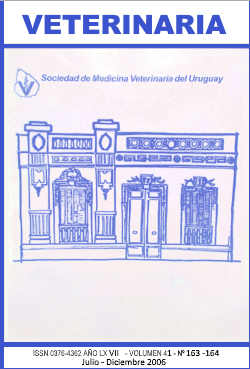Relevamiento de helmintos intestinales en perros urbanos de Montevideo y Florida, y perros rurales del departamento de Florida, con el registro de un nuevo género de nemátodo parasitando al canino en nuestro país
Palabras clave:
Intestinos, Perros, Nematodos, Enfermedades parasitariasResumen
Se presenta el relevamiento parasitario del tracto intestinal de 95 perros, 56 procedentes de áreas rurales del Departamento de Florida, 30 de la ciudad de Montevideo y 9 de la ciudad de Florida. Para 11 de los tractos (todos ellos de procedencia rural), no se dispuso de ciego ni de intestino grueso. Se encontró al menos una especie de helmintos en 71 (74.7 %) de los intestinos. Se colectaron 5964 helmintos en total, incluyendo dos ejemplares de un nemátodo trichostrongiloideo del género Molineus que se registra por primera vez parasitando al perro en Uruguay. Las otras especies de helmintos encontradas fueron Dipylidium eaninunl, Taenia hydatigella, Aneylostoma sp., Toxoeara canis y Triehuris vulpis. De los intestinos positivos, 19 presentaban una sola especie de helminto, 27 presentaban infecciones dobles, 19 infecciones triples, cuatro infecciones cuádruples, y en dos intestinos se encontraron infecciones quíntuples. Cuatro especies de helmintos (Aney/ostoma sp., T. eanis, T. vulpis y D. eaninum) estuvieron presentes en perros de todas las procedencias, y siempre con niveles altos de prevalencia, intensidad y abundancia de infección. Las restantes dos especies, T. hydatigena y Molineus sp., se hallaron sólo en perros rurales y con bajos índices de infección. La razón entre el desvío estándar y la intensidad media fue mayor a 1 en todos los casos, indicando distribuciones agregadas de las poblaciones de helmintos. La razón sexual de las tres especies de nemátodos más prevalentes, en concordancia con 10 que predice la teoría, fue mayor a uno. Se comparan los presentes resultados con relevamientos anteriores realizados en el país.











